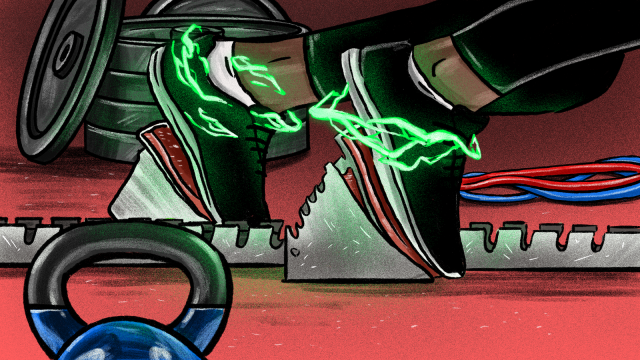Too often, runners try to improve by focusing exclusively on their running. They attempt faster workouts, higher mileage, speedier overall paces, or more frequent workouts. This approach may lead to injuries, as more training is inherently risky. (We don’t call them “overuse injuries” for nothing!) Instead, if runners focus on their capacity for more training, they’ll eventually be able to run more.
Capacity-building training improves your ability to train even more, whether that means more volume, more intensity, or both. And the best way to improve your capacity for more running is with strength training.
A consistent strength program includes many benefits for endurance runners:
- Faster finishing times, because you can recruit more muscle fibres and therefore, run more powerfully.
- Fewer overuse injuries, because strength work improves the durability of your muscles, connective tissues, and joints.
- Better running economy, because you’re more coordinated.
In fact, strength training is so important for runners that it shouldn’t be considered cross-training — it’s part of the training all runners must do if their goal is to reach their true potential.
But if you’re a runner intimidated by the gym or who’s never done any strength training before, how do you start?
It’s important to keep in mind the principle of progression.
Where to start if you’re brand new to strength training
Most runners understand that to improve, their training must become more challenging and complex over time. This is called progression, and it helps runners gradually achieve more as they adapt to higher levels of mileage and overall intensity.
You can do this with your strength training, as well. If you’re brand new to strength work, begin with relatively simple bodyweight exercises with a focus on consistency.
At this stage of your running career, it’s most helpful to build the habit of consistent strength training, so start with a series of bodyweight workouts that follow each of your runs. By finishing each run with a small amount of basic strength training, you’ll build a long-term habit that lasts.
Stick with fundamental exercises like:
- Squats (and their single leg varieties)
- Deadlifts (and single-leg deadlifts)
- Planks
- Bridges
- Lunges
- Step-ups
- Push-ups
- Press (and the push press)
The Mace Single Leg Routine below combines many of these exercises into a single workout that addresses single-leg strength:
And the Standard Core Routine is a “bread and butter” core workout specific to runners:
These routines help you build strength in a way that’s challenging but approachable to most athletes. And by completing one routine after each run, you’ll build the foundational strength needed for more advanced lifting if you choose it.
How to add weights and more challenging moves
If you’re new to strength training, it’s not a smart idea to jump into a series of heavy deadlifts on day one. Instead, start with the routines in the previous section, which are far more general.
General strength forms the foundation that allows runners to progress to more advanced lifts in the gym. After 4–6 weeks of consistent bodyweight workouts, you’ll be ready to progress to more advanced exercises.
A valuable way to bridge the transition from bodyweight core exercises to difficult gym workouts is by starting with easier implements like bands, medicine balls, and kettlebells. These tools enhance your bodyweight or add only a relatively small amount of weight.
You’ll be practicing many of the same movements that you will in the gym, but with less weight. Routines like the Tomahawk Workout are great “in-between” workouts for when bodyweight exercises are too easy but you’re not quite ready to get into the gym.
After another 3–5 weeks of strength training with at-home implements, you can progress to more advanced lifts in the gym. These more challenging gym workouts will include many of the same exercises (squats, deadlifts, press) but will be done with a weighted barbell.
Scheduling is also different because you can’t lift heavier weights every day, so you won’t be following every run with one of these workouts. Instead, you can lift relatively heavy weight in the gym twice per week and keep the bodyweight workouts for after your other runs during the week.
Strength-building tips to remember
Runners’ goals with strength training are simple: get strong, improve efficiency, build injury resilience, and increase power to improve racing performances.
Because of that, you don’t need to lift like bodybuilders by focusing on individual muscles and long workouts. That isn’t as helpful for runners.
Instead of isolating specific muscles, runners should train movements. Compound, multi-joint exercises like the squat and deadlift will not only help runners get stronger, they’ll build coordination and general athleticism. So skip the bicep curls and focus on the fundamental lifts.
And since our goals include efficiency and power, you have to lift relatively heavy weights. Light weights won’t challenge your muscles and nervous system enough; you have to lift challenging amounts of weight for these desired adaptations.
But with that said, prioritise your running. Lifting is secondary to running so when in doubt, lift slightly less weight than you think you can. Runners are engaging in coordination training under resistance when they’re weightlifting, so the exact amount of weight is less important than good movements.
If you’re finding yourself too fatigued or sore to run because of lifting weights, or unable to meet the desired pace or splits during a workout, you’re likely lifting too heavy. Reduce the weight and you’ll likely find that your energy for running will quickly return.
Ultimately, runners don’t need to fear lifting weights. It won’t make you bulky or too stiff for your running. But it will make you stronger, improve your body composition, increase your speed and running economy, make you more powerful, and reduce your risk of running injuries. And those are all things every runner wants.

Leave a Reply
You must be logged in to post a comment.